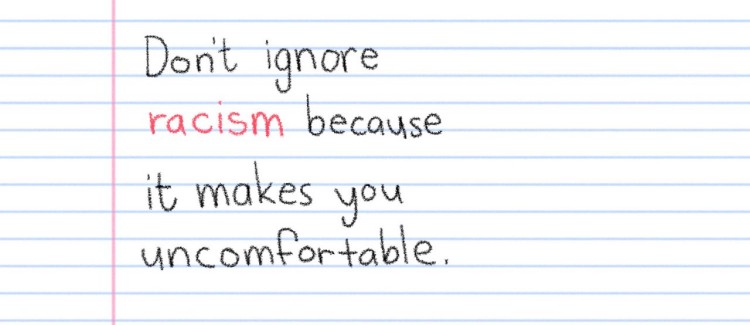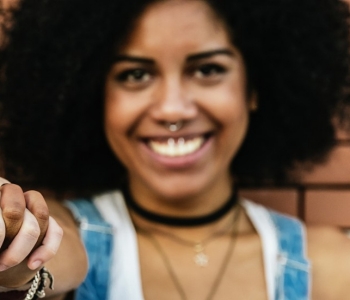Help Your Kids Take Action Against Racism

Whenever we see injustice, we all have a responsibility to confront it. Every day, no matter our background or our age, every single one of us has a role to play in taking on an unfair system while working to build a new one that truly works for all. Guiding our girls in learning to recognize and challenge structures and practices that fuel inequality and cause harm helps them play an active role in creating the positive change our society needs.
While we should be having conversations about race and racism regularly, checking in with your girl is crucial when racist violence claims lives and sparks widespread protest, grief, and unrest around the nation. Kids of all ages, backgrounds, and skin tones are feeling a range of emotions in response. They’re sad, scared, angry, and confused.
What’s the number-one thing that can help your girl process these feelings? Talking with an adult she trusts and loves—you—and then finding ways to take positive action.
It may be tempting to avoid the topic of race and racism altogether—especially for those who were taught it’s something that isn’t polite to discuss—but statistics show that justice, health, and education systems aren’t fair in basic ways that can negatively affect a girl’s life on a foundational level. Her family, education, safety, and well-being make these conversations a must for those who support a just and equal world for all girls.
- Race-driven violence against the Asian American Pacific
Islander community has skyrocketed in the past year, especially in
major cities. Young people under 17 were targets in 12 percent of
these reported incidents, and women were more likely to be targeted
than men according to Stop AAPI Hate.
- Since
the start of the pandemic, three in every ten Asian American Pacific
Islanders have been faced with racist slurs or racist jokes,
according to the Pew Research Center.
- In
every state, black girls are twice as likely to be suspended from
school as white girls even though they don’t misbehave more
frequently, according to a 2019 study by the National Women’s Law
Center. These suspensions impact her educational attainment and
career prospects.
- Children raised in Black,
Latinx, and Native American households are more likely to live in
homes with higher unemployment and lower incomes than white
children. These inequities increase their risk for health problems
and make it more likely they will receive less, and lower quality,
education, according to the American Academy of Pediatrics.
- Youth of color are more likely to be incarcerated than white youth, disrupting their education, impacting their health and emotional well-being, and limiting their options for the future.
Having honest discussions about race is important for all families, and it’s vital to have them on a regular basis, even if you find it uncomfortable or you think your kids already know about racism and understand right from wrong. Yet while discussion is great, it’s only one part of it. It’s also important to look at how your girl’s life is structured and lived every day. Who does she see in her neighborhood, at school, and in positions of power around her?
So, how do you begin?
Be straightforward, ask questions, and listen to her.
For starters, don’t avoid the topic. Pressing mute can make your
girl think that talking about race and racism is off-limits or that
the status quo is acceptable, when real conversation on these topics
is actually what she needs most and what will help you both be part of
the solution.
In fact, "choosing" whether to talk to your kids about racism and its consequences is not a decision every family gets to make. It’s often a necessary, even life-saving, conversation from the earliest ages, especially for black families and other families of color.
Trish Tchume, who works on racial justice issues across communities, remembers her mom initiating a conversation with her when she was just five or six years old about how, as a black girl, she would be treated differently than her white friends.
"She was telling me that when I was with my mostly white friends at the mall or out at the pool, they’d come up with ideas of ways to test boundaries that might be harmless for them, but that would not be harmless for me. She was telling me to think and be more careful because black kids—and adults, too—are treated differently than white kids when they talk back to authority figures or break the rules" like all kids do at some point.
"My mom wasn’t trying to hurt my feelings, she was trying to keep me safe," she adds.
You don’t need a big speech. Ask what she’s seen and heard and listen to what she says. Let her know that whatever she’s feeling is OK, including if she’s scared, uncomfortable, or angry.
"You might think she’ll feel more afraid if you admit you don’t have all the answers, but in my experience with kids, and in fact all humans, people feel comforted and better supported when they’re met with honesty and emotion," says Ms. Tchume.
Teach her to identify racism.
To make discussion about
race and racism a part of "normal" conversation in your
home, start when your kids are young. According to Dr. Erin N.
Winkler, who studies talking with children about race, it’s never too
early to start.
Young children start to reflect the bias prevalent in their society. In the U.S. that often means a bias toward whiteness.
"If you look at the media they are consuming and what comes out of that—the princess or character they want to be for Halloween for example—you can see that it starts early," says Dr. Winkler.
So, what can you do? It’s important to pay attention to what’s in your home. Having toys, books, and shows you watch that feature diverse characters in a variety of roles can help balance a narrative from society that often only places white characters at the center.
Talking about who’s left out and who’s included, and how they’re
treated when they are included, is important. When you read a book or
watch TV with your girl, are the characters diverse? If there are
Black, Latinx, Native American, or Asian American Pacific Islander
characters, how are they portrayed? Are they in a lead role? Do they
reflect stereotypes or do they have dimension? Beyond characters in
books and movies, when she’s in school and learning about history,
whose history is she learning about?
Whenever you’re met
with exclusion based on race, ask if she thinks that’s fair, how it
makes her feel, and how your family might work together to fight these
everyday types of racism.
"Fairness is a really great way into this topic with kids. It’s a concept they understand," says Dr. Winkler.
Teach her the value of diversity and inclusion, and to embrace our
differences.
Saying "we’re all the same" or
"I don’t see color" might be well-intentioned, but it
perpetuates racism because it disregards part of people’s identities.
Plus, saying everyone is the same implies that everyone has the same
experiences and is treated the same in our society—which statistics
and the everyday discrimination faced by Black people and other people
of color show isn’t the case.
Instead, talk with your girl about how we can honor and celebrate our differences, and about how we all, with our unique backgrounds and experiences, bring beauty to the world in so many different ways.
"I’m proud and excited to be Black. Anything that causes another person to erase a part of who they are to fit in, to be seen, to be loved? That’s not good or helpful," says Ms. Tchume.
Empower her to challenge racism when she sees it.
Racism
isn’t always violent or overt. It appears in many forms, and it is
rooted in the false belief that the white experience is standard and
that white people are superior to others.
Your community and what she sees every day in her world counts.
"It’s not just what you say, it’s also what you do and what she sees and the way everyday life is set up for her. What does she hear at school? Who does she see in your neighborhood? Kids take all of that in and learn by seeing what’s around them. It influences how they see race," says Dr. Winkler.
Also, some parents approach racism as a "settled issue," when it’s still very much an issue in the everyday lives of many families.
Racism didn’t end with the Civil Rights Movement. Showing kids that people like Martin Luther King Jr. and Rosa Parks, as well as everyday people who’ve taken action against injustice, had roles in making change can help them understand we all have a role to play and that they can help make things better, says Dr. Winkler. It empowers them. "Teaching them to look for the people in the community who are helping, and showing them that there are people out there committed to making change now is also a great way" to engage kids.
Learn and take action together.
Although families of
different backgrounds come to these conversations from different
places, one thing that can help many parents and caregivers is
educating themselves to increase their understanding and comfort
level, says Dr. Winkler. "If you can’t explain systemic racism to
other adults, it might be hard to explain it to young children in a
way that feels right to you."
Ms. Tchume suggests being open and talking with your girl about the fact that you’re learning at the same time she is. Seeing that grownups don’t have all the answers either, and that you often have to do some work to find out the best ways to help, will show her that making meaningful change takes patience and dedication.
You can also talk with her about actions you’re taking for positive change as an adult, including voting. Let her know about things she can do or that you can do together as a family. Writing letters to your elected representatives urging them to support anti-racist policies (and holding them accountable for their actions) and connecting with groups in your community that are working for equality are just a few of the many ways you and your girl can help build a just world for all.
Here are some additional resources to support you:
-
The
National Museum of African American History and Culture’s “Talking
About Race” resources for parents and caregivers
-
The Conscious
Kid
-
EmbraceRace
-
Tips for civic
engagement and taking action through the G.I.R.L Agenda
- Additional tips from Raising Awesome Girls on how to talk to her when she encounters violence on the news and social media
There are few topics more complex than race in the U.S. The resources and conversation starters above represent just that—a start. We’re committed to continuing the conversation by bringing a range of voices to the table, listening to each other, educating ourselves, and recognizing that we all start from different places. We all have a role to play in bringing about the world we want to see for our girls. Join us in the effort. —The Raising Awesome Girls team





